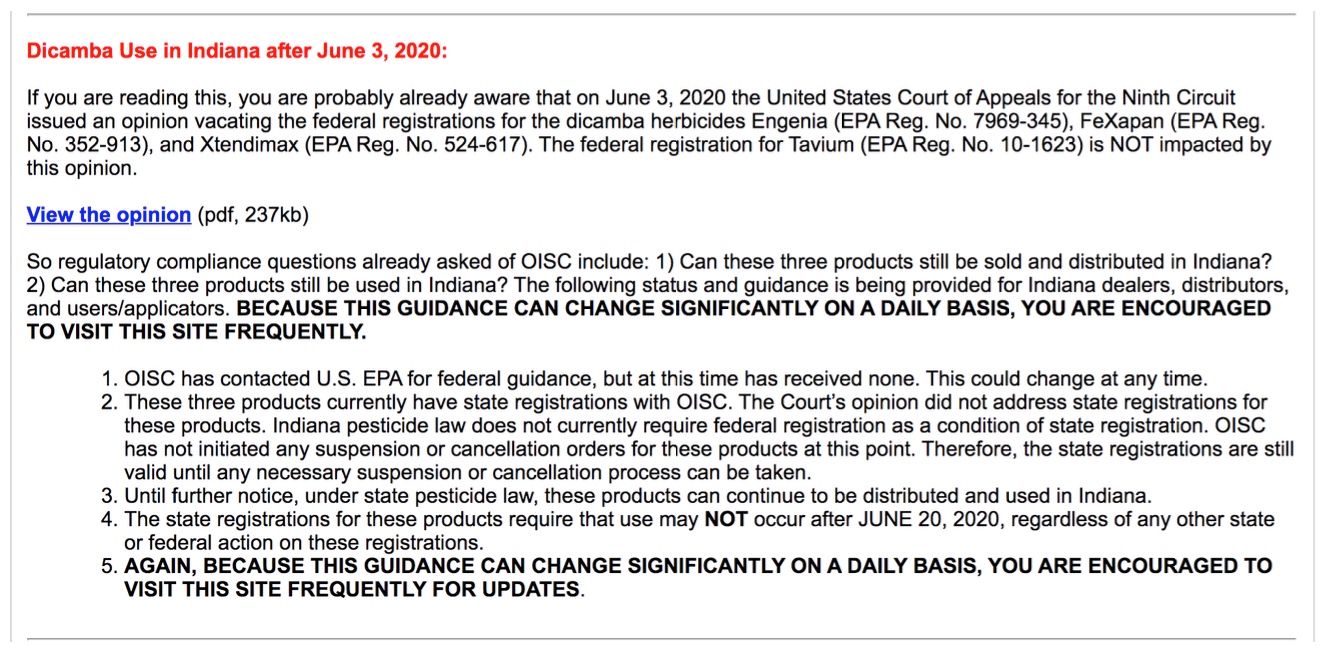By now most of you are aware of the ruling in the 9th Circuit Court that vacates the labels Xtendimax/Fexapan, and Engenia. As of Friday morning, June 5, most regulatory agencies in the states are scrambling to interpret and communicate the short term future of using these products to control weeds in Xtend soybeans to growers in their respective states. The Illinois Department of Ag has issued a stop use and sale of these products. In Indiana, the Office of the Indiana State Chemist will post their guidance at this website – https://www.oisc.purdue.edu/pesticide/dicamba.html. Here is the statement that was posted this morning at 9:30 am.
In the short term it would be prudent to make alternative plans for postemergence weed control in Xtend soybeans.
- The ruling affects Xtendimax/Fexapan and Engenia, but not the Tavium product (dicamba + metolachlor). As of today, OISC is allowing Xtendimax/Fexapan and Engenia to be distributed and used. But that could change on short notice. If OISC stops the sale and use of these products, there is still one dicamba product (Tavium) that can be applied up to June 20. However, keep in mind the cut off date for Tavium is the V4 stage of soybean growth, and many fields are probably past the stage.
- For fields that have waterhemp, the most broad spectrum herbicides that can be tank mixed with glyphosate for control of glyphosate and ALS resistant weeds will be fomesafen, lactofen, or acifluorfen. Remember that these are group 14 (PPO inhibiting) herbicides and will not control PPO resistant waterhemp that is very prevalent in some, but not all parts of the state. These herbicides will also help with controlling morningglories.
- For fields that do not have waterhemp, the group 14 herbicides mentioned above will help with many broadleaf weeds, but will be weak on marestail, lambsquarter, and large giant ragweed.
- For fields that have giant ragweed and marestail that is not ALS resistant, cloransulam or chlorimuron can be used.
- If you have giant ragweed and marestail that is glyphosate and ALS resistant, your best bet is to apply the highest rate of glyphosate allowed by the label and tank mix a ½ rate of cloransulam and a ½ rate of chlorimuron with it and have a hand weeding crew ready for deployment.
- For fields that have lambsquarters, a product that has thifensulfuron, imazamox, or flumiclorac in it will help.
At this time this is the best advice we can offer for control of these weeds in Xtend soybean. The use of these alternative products will require more thought and planning than we have grown accustomed to. It won’t be as simple as just dumping something different in the tank and heading to the field to spray away. Keep in mind that sprayer set up with the proper nozzles, carrier volume, and adjuvants will be key components for these alternative herbicide applications to be successful.



